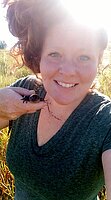The Effects of Sodium Chloride Exposure on Canadian Toad (Anaxyrus Hemiophrys) Larvae

Alicia Schlarb: is a Masters graduate student in the Environmental and Conservation Sciences program at North Dakota State University (NDSU). She holds a Bachelor of Science in Zoology from Oklahoma State University (OSU). She previously has worked for the United States Fish and Wildlife Service, the National Park Service, and the Agricultural Research Service as a Biological Science Technician. Her current graduate research focused on the effects of sodium chloride on Canadian toads (Anaxyrus hemiophrys) larvae and post-metamorphic juveniles. The goal of her work is to understand the impact that sodium chloride has on Canadian toad larvae survival and development, while also highlighting the effects it has on them after metamorphosis occurs.
The Effects of Sodium Chloride Exposure on Canadian Toad (Anaxyrus Hemiophrys) Larvae
Sodium Chloride (NaCl) production in the United States is at an all-time high. As weather patterns become harsher through climate change and demands on energy and agriculture increase, evidence of long-term NaCl exposure is emerging throughout environments. With a focus on Canadian toads, this research seeks to fill existent gaps of NaCl effects on tadpoles and post-metamorphic juveniles for this species.
The first portion of this research examined the effects of NaCl on larvae exposed at multiple developmental time periods. Exposure to sodium chloride occurred as eggs. Using a new subset of tadpoles, exposure also occurred at an older Gosner stage of 20. Weight, survival, and time taken to complete metamorphosis, along with hatch success were measured. This research further examined the effects of NaCl infused substrates on post-metamorphic juvenile choice, weight, and consumption. Specimens were individually kept in containers filled with sodium chloride infused coconut fiber for 20 days. Cricket consumption and weight were monitored. A separate subset of juveniles was used in timed choice trials, where an individual’s time spent on the saline or non-saline surface was recorded. Additionally, wetlands across the Fargo urban landscape were measured and monitored for sodium chloride levels starting in March 2020 until August 2020 to provide insight into relevant levels. This was conducted using a YSI meter and Chloride Quantab test strips.
Progress:
As of October of 2020, research was completed. The highest salinity level did not have any survivors to metamorphosis. It was found that weight and survival at metamorphosis were not affected by NaCl at lower salinity levels, despite the exposure time. Time taken to complete metamorphosis was extended in tadpoles exposed at an older Gosner stage. The effects of NaCl infused substrates significantly increased weight gain and decreased consumption rates in high saline treatments, while salinity did not affect the toad’s choice between saline and freshwater substrates. Levels of sodium chloride started high across the wetland sites within Fargo, ND, and steadily decreased as the warmer season progressed.

Matthew Smith
Biological Sciences
Office: Stevens 118
Phone: (701) 231-7628
Email: matthew.thomas.smith@ndsu.edu


